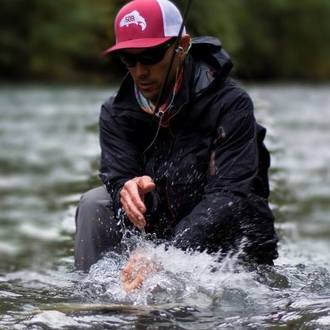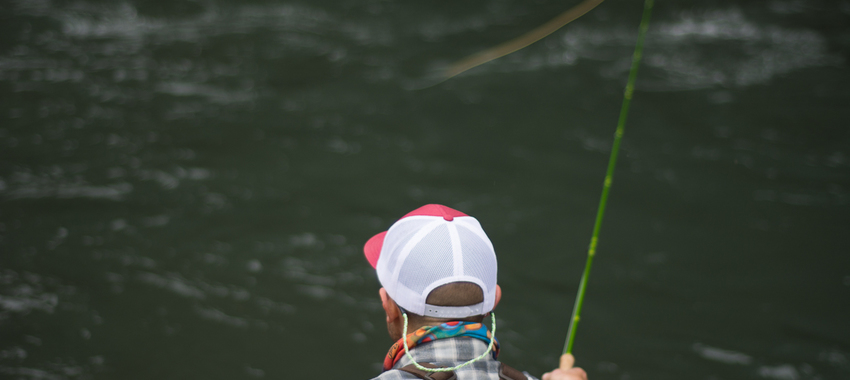Secrets to Successful Spey Fishing
November 11, 2015

I have had the fortune of getting to be a professional guide/student of fly fishing for 16 years. By student I mean that I get to watch and observe most of the time. In a given day I might teach half the day, the other half I simply get to observe the angler at work and give them a chance to progress. You guys that fish with me right now are laughing, "he doesn't just watch! he is always yacking at us"! Yea, I do yack at you but get a cleaner presentation and I won't have to bug you so much!
Sometimes watching the neophyte angler is a beautiful thing to witness... other times it makes you want to shove your head under water. Not really, but you get the point. As an observer and a student, I am emotionally unbiased therefore I tend to see what works and what doesn't'. Things are very clear to you while observing in this role. Details jump out. You see what was an efficient use of energy, and what actions are a waste of time and energy. The important part is... I am emotionally unbiased. This is key. When its "your" cast, anglers have an emotional attachment to their cast and fail to see it for what it is. Often it simply doesn't work. Maybe it was a good cast from an aesthetic standpoint, but it was angled too far upstream, they over mended, it was too far downstream, or they held their rod at the incorrect angle during the swing. As the observer I see truth. Some casts that didn't look like much, might be very functional. On the other hand, casts that look like something fancy... don't have a chance in hell of hooking a fish.
In all of this observation you really have to become a stenographer and log the positives. Watching, observing, not always talking, and formulating plans for solving the angler's challenges is what I do. Over the last several years I have been studying in depth how anglers swing flies for Steelhead more than any other discipline. I pay attention when I am watching guys fish. When you guide swing fishing, it is almost imperative that I leave the angler alone, watch, and make only small corrections and suggestions. Anglers must concentrate on the presentation without interruption. Its critical. This is high stakes fishing, its too late in the game for trying to micro manage a cast and allow myself to be a distraction. Most of the time, when we practice - WE PRACTICE. When we fish - WE FISH. Its tough for anglers to be in practice and play in the championship game at the same time.
I have watched hundreds upon hundreds of thousands of casts and swings for Steelhead over the last several years and there are some nuances to the game that are tough to explain but I'll give it a try with a list of thoughts. There is a lot more to learn beyond what is here, but these are some things that I notice in watching the average angler.
- Start with the Basics - If you want to get GOOD at spey, buy the video set listed below. Too many guys just get out there and attempt to invent new styles of casting each time they hack away. Some of you look like you are imitating Luke Skywalker on acid. Whipping and waiving the rod all over the place like your being shot at by a bunch of Storm Troopers. Its ridiculous sometimes. I would rather see an angler fish a cheap rod and watch these videos than have them buy the most expensive rod and skip it. RIO Modern Spey Casting 3 DVD Set. Youtube can't touch this.
- Don't snag the far shore. This is one of the dumbest things you can do. I'm sorry, but in spey casting we have already measured out our line length, we're standing stationary in one spot taking 1-2 steps after each cast. Unless the trees on the far shore are growing at several feet per minute there is no reason to snag that far shore. It totally wrecks whatever mojo you had going. Do this and you owe your guide your sandwich at lunch AND lose your spot if you were first fly through the run.
- If you want to catch fish on a swinging fly - FISH A SWINGING FLY! - This might sound really dumb. But I can't tell you how many people are fascinated by the idea of catching steelhead on a tight line, a direct connection, a grab in which you immediately feel the power and energy of that fish upon the hookup, and done in a way that is clean. Its awesome! So many of you want that, but when push comes to shove... you stick with the bobber rod 80% of the day. Go to the spey rod 100% instead and invest some time in learning to fish it. Dabbling in it here and there isn't the way to be successful. Don't be scared, take this challenge head on and own your destiny. So what if you don't catch any fish at first, you'll be better off down the road. Your ego can handle it. It might be a rough night back at the lodge listening to all the nymphers talk about their steelhead but you'll get over it. If you want to spey, spey.
- Its Cool to Cast short. I see anglers rip out the shooting head plus 20' of running line all the time and throw far beyond many suspecting targets! You would never do this with your single hand rod - why do it with your two handed rod? The best anglers I see cast to where the catchable fish are. The fish on the other side are not always catchable and you would only target those after you fished the middle and near ledge first.
- Why Mend? Sometimes you do, sometimes you don't. I see anglers mending all the time for no reason. It kills their coverage range and the elapsed number of seconds the fly actually fishes on a given cast is reduced by more than half. If you mend, do it for a reason. Its ok to let nature take care of this most of the time especially if you have a decent cast.
- Get Your OWN Gear - I'm not afraid to say it. You guys borrowing spey rods from the guides every fall need to pony up and get your own sticks if you want success. That is like expecting to play a decent round of golf using borrowed clubs. By using the same rod every time, your own rod, you will have familiarity and responsibility. You are now IN the game. Here are a few setups that I like: Sage ACCEL and Domain Reel (higher end), Redington DUALLY Setup (more affordable). If you want the buy the best and never look back, the Sage MOD Spey Rod is the finest two handed rod I have ever cast (my opinion).
- There are too many spey casters and not enough spey fisherman. Be a spey fisherman. The cast is only a means to the hookup. Adopt this mentality and your casts will clean up, swing will be smoother, and you will generate more hookups. Its about being fishy.
- When fishing sink tips, the process of your fly "lifts and turns" is THE MOST CRUCIAL part of your presentation. Time the lift and turn correctly and you'll out fish your partner 3:1
- Twice Fast is Better Than Once Slow - This isn't my quote, a guide in Alaska that I studied under told me this. Step through the run, step back to the top and try again. This is far more lucrative than working the water slowly.
- Utilize the Element of Surprise - Think of your swing like an ambush. This means stepping through the run, casting clean every time, and keep your feet moving. Surprise the fish with your offering rather than showing it to him several times before you step down into them. If the water has 4+ feet of visibility take 2-3 steps after each cast, 3-4' take 2 steps, less than 3' take one step.
- Cast Tight - Nobody cares about your 60' cast if you used 80' of line to get it. Shorten your line or learn to cast better. Your sink tip, leader, and fly must be presented in a very clean and seductive manner. Sloppy doesn't catch fish.
- Don't cast beyond center! I see this all the time. Its one of the worst offenses, it should be punished by having to watch your guide fish the entire run while you sit on the bank. At the top of the run, often the fastest water is in the center. Don't cast all the way over the fast strip of water! This causes all sorts of problems. At the most, cast just beyond center at a downstream angle, and mend your fly back to center so it can sink and swing from the center to the near ledge. The swing is horrible when anglers pitch a bunch of line across in the top of the run. Especially if its their first pass through.
- Tighten Your Loops - This is important for so many reasons, mainly because it will force every other element of your cast to come together. Your presentation will improve if you learn to cast a tight loop.
-
Thanks for sharing Joe, this is great stuff! When I first started spey casting, I opted not to invest in Rio's Modern Spey Casting DVD. What a mistake that was! After spending many hours on the river hacking away, I finally purchased it. After watching it a time or two, I saw immediate results. It turned me from a hack to an effective caster able to present a fly to the fish in a consistent manner. The skills taught in there are NOT on YouTube like you said! Also, thank you for pointing out that it is okay to cast short with spey gear. I think many of us (myself included) watch too many fly fishing videos with clips of anglers shooting ridiculous lengths of running line. As you indicate, that does not always catch fish and sometimes it is flat out not necessary. Thanks again for the awesome tips, and keep up the great posts!
-
Thanks Jordan, keep swingin' buddy.
-
What is your opinion on Rod Angle through the swing? I have seen it all from rod tip pointed right at the fly, horizontal with a reach, to 45 degrees feeling the chug. Thoughts?
-
Hello Joe, very good article for the spey angler. I have a question about the sink tip fishing "lift and turn" optimal time. When should this occur? Does it mean to have the tip and fly swinging in front of the target when the tip is fishing the deepest? Could you please explain. Thank you. Andy
-
There are no video sets listed below.
![Reds Fly Shop [logo]](/img/reds-fly-shop/logo.png)
